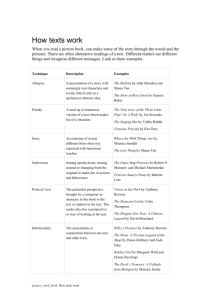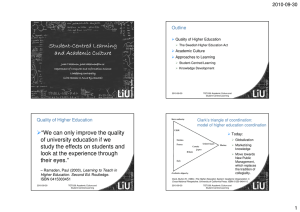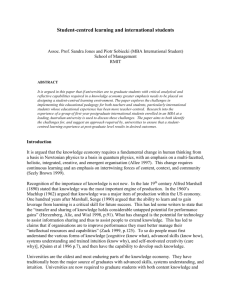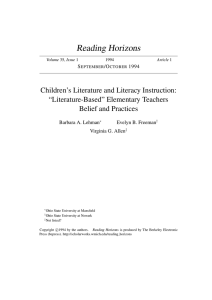Essay.doc - English Department
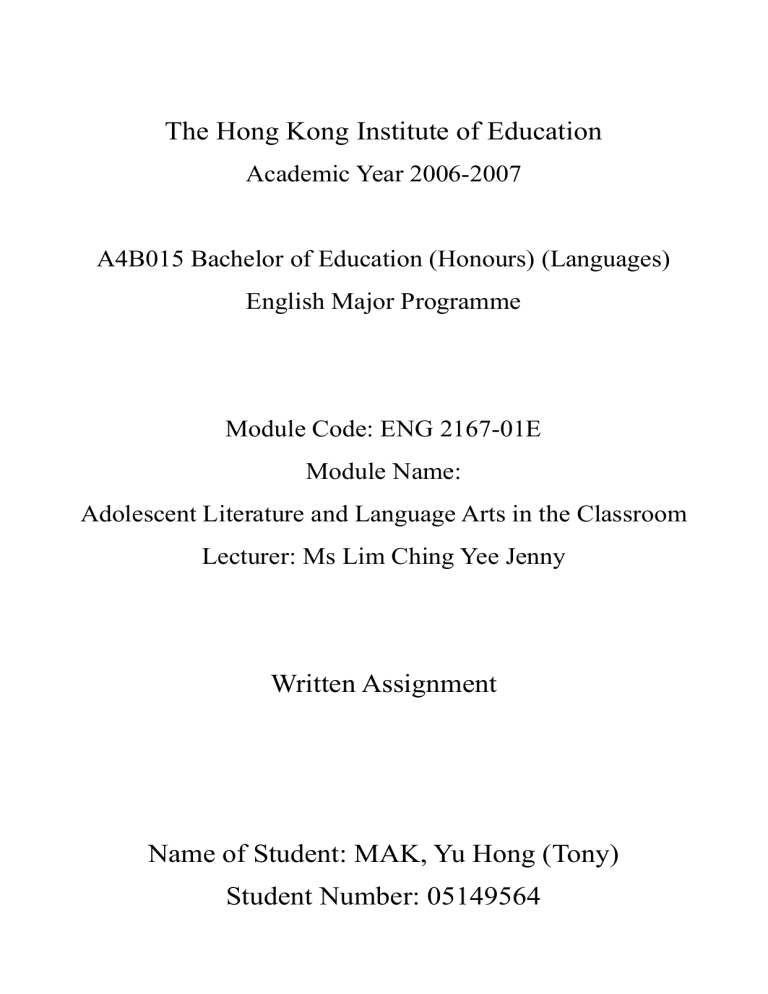
The Hong Kong Institute of Education
Academic Year 2006-2007
A4B015 Bachelor of Education (Honours) (Languages)
English Major Programme
Module Code: ENG 2167-01E
Module Name:
Adolescent Literature and Language Arts in the Classroom
Lecturer: Ms Lim Ching Yee Jenny
Written Assignment
Name of Student: MAK, Yu Hong (Tony)
Student Number: 05149564
A Short Essay
Discussing My Rationale of the Design of My Language Arts Materials
Adolescent Literature Lesson Plans Designed for Secondary Four Students
Introduction
Adolescent literature refers to the integration of literary texts in ELT (Falvey and Kennedy, 1997). It is believed that using literacy texts facilitates youngsters’ literacy development (Moore, Bean,
Birdyshaw & Rycik, 2005). Readers respond to the literary texts for developing their four language skills in language arts activities. Language arts allows students to learn English and develop their oracy and literacy skills “through the use of imaginative texts such as poems, novels, short stories, dramas, films, film scripts, jokes, advertisements, song lyrics, and radio and television programmes.” (CDC and HKEAA 2006, p.84) In this essay, I will discuss the rationale of the five language arts lessons plans I developed for creation a literature-based classroom facilitating students’ English learning through language arts activities.
Overview of Target Students and the Focus of My Resource Package
Five lesson plans are designed for teaching language arts in the senior secondary four English language curriculum. The lessons focus on the theme “A Beautiful Mind”. Three genres – poem, film and drama – are adopted in the lessons. Form my perspectives, students need to understand themselves deeply and further develop their value-system in order to help them accept and overcome life challenges easier. Therefore, the theme “A Beautiful Mind” is set as the focus of my resource package fostering students’ language development as well as cultivating them to develop a beautiful mind.
Rationale for the Design of My Resource Package
1. Student-centred learning and reader response
My lessons emphasize student-centred learning in order to fostering students’ language development though responding actively to the literary texts and media. Pair works and group works are the outcome of student-centred learning. Through Adopting cooperative learning principles, students are encouraged to respond to the imaginative texts actively. The activities I designed match the “three components of reader response” – “(1) the reader, (2) the literature, and
(3) the context for response (Galdda, 1988)” (Hancock 2004, p.9). For instance, activities like
“rewriting stanzas” (lesson 2) draw students’ attention to the structure of the poem “Don’t Quit”. It allows students to respond to the poem through the re-writing process. The students interact with the poem to generate their unique responses through re-writing a stanza. Three components of reader response are all presented. It helps students to develop their literacy skills under student-centred learning environment.
2. Literature-based classroom
My resource package include a variety of activities like poems reading and rewriting tasks, discussions, persuasive task and mini-drama task aiming for creating a literature-based classroom.
Students can immerse in a literature-rich environment to facilitate their English learning. Since literature based classrooms has an enormous value on developing students’ language skills and fostering their learning strategies for getting high scores (Houghton Mifflin Company 1997), different kinds of activities for every genres are included not only build up students’ English proficiency but also provide them opportunities to develop studying skills through responding literature with their partners and group-mates.
Conclusion
Language arts is a new element embedded into the New Senior Secondary (NSS) English Language curriculum. My resource package can be adopted for teaching the new curriculum. Through various re-structures and amendments of the lesson plans (See Appendix 6 to 9 for the 4 drafts of the lesson plan), the final products of my resource package with appendices are attached.
(550 words)
My Resource Package
1) My Lesson Plans
2) Teaching Materials (See Appendices)





